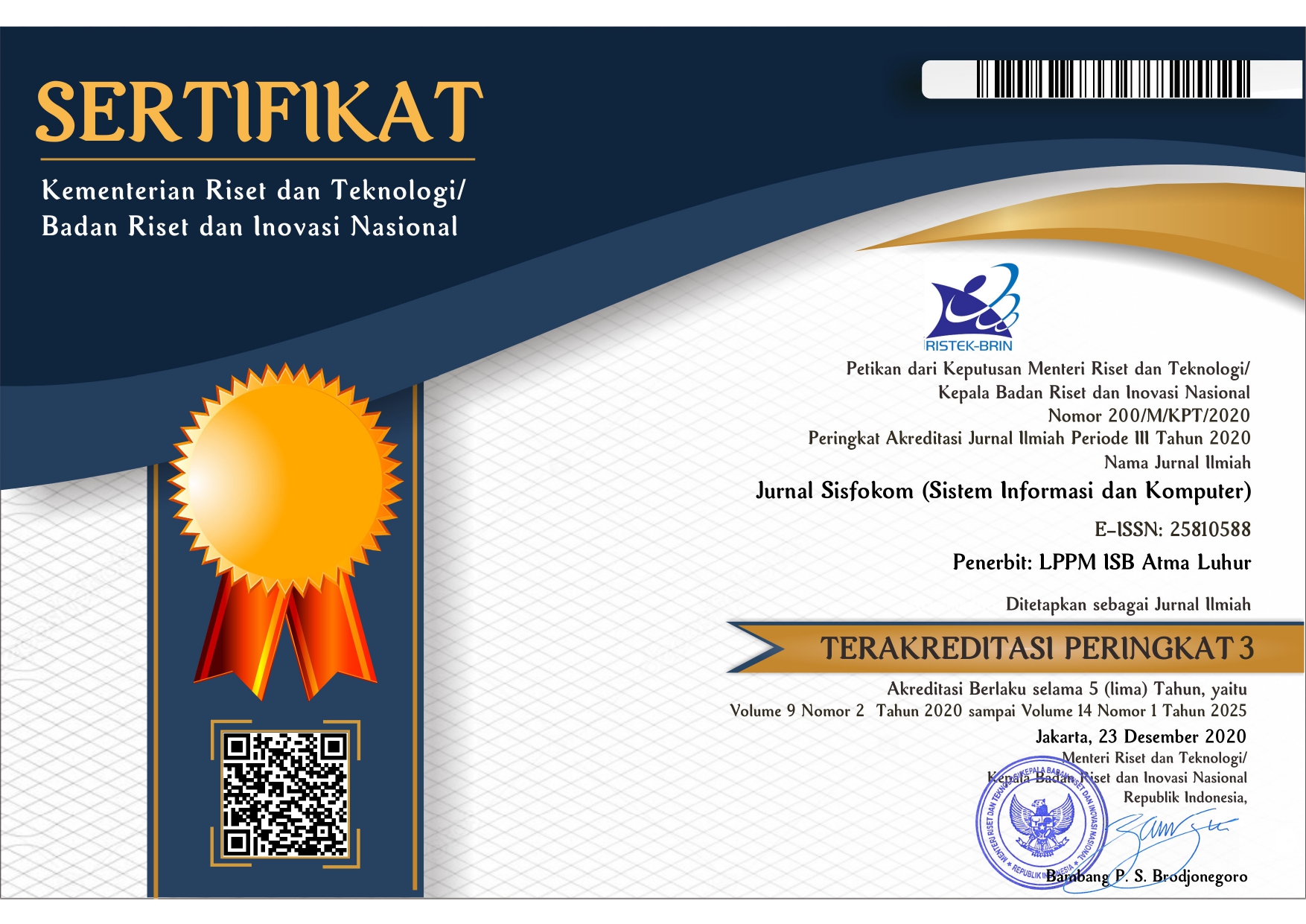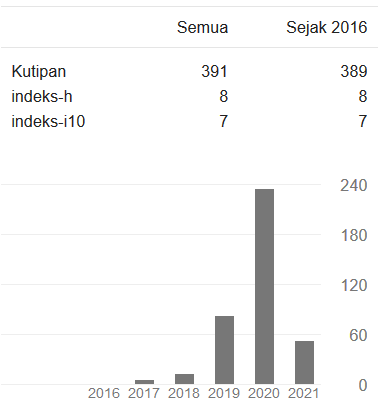Performance Analysis of CloudLinux-based Web Server at the Embassy of the Kingdom of Morocco in Jakarta
DOI:
https://doi.org/10.32736/sisfokom.v10i2.1168Keywords:
Web Server, Uptime, Response Time, Load Impact, CloudLinuxAbstract
The rapid development of Information Technology (IT) has made a high availability web server a necessity. CloudLinux is a CentOS-based operating system specifically for the needs of servers with good high availability. This study will implement and analyze a CloudLinux-based web server for the Embassy of the Kingdom of Morocco in Jakarta to replace the current CentOS-based web server that does not meet high availability standards. The research methodology used in this study is the PPDIOO Life-cycle from Cisco. Designing a network according to the customer's needs requires identifying several elements in it, including the goals and constraints faced by the organization. Cisco creates a network life-cycle that can help these problems into six phases: Prepare, Plan, Design, Implement, Operate, and Optimize (PPDIOO). This study aims to determine how well the uptime, response time, and load impact are on the CloudLinux-based web server. The uptime test results on the CloudLinux-based web server have a value of an average of 99.971%. Testing the response time on the CloudLinux-based web server has an average value of 684.75ms (milliseconds). The results of the load impact test on the CloudLinux-based web server using ten virtual users (10VU) has a total value of 7595 requests, load impact using fifteen virtual users (15VU) has a total value of 11315 requests, and finally, load impact using twenty-five virtual users (25VU) has a total value of 18631 requests.References
I. Nurhaida, D. Ramayanti, and I. Nur, “Performance Comparison based on Open Shortest Path First (OSPF) Routing Algorithm for IP Internet Networks,” Commun. Appl. Electron., vol. 7, no. 31, pp. 12–25, Sep. 2019, doi: 10.5120/cae2019652838.
A. Megahed, A. Nazeem, P. Yin, S. Tata, H. R. Motahari Nezhad, and T. Nakamura, “Optimizing cloud solutioning design,” Futur. Gener. Comput. Syst., vol. 91, pp. 86–95, Feb. 2019, doi: 10.1016/j.future.2018.08.005.
B. Dobran, “Data Center Tier Classification Levels Explained (Tier 1, 2, 3, 4),” phoenixNAP, 2020. https://phoenixnap.com/blog/data-center-tiers-classification (accessed Apr. 19, 2021).
PERSISMA, “Contact Us,” PERSISMA, 2013. https://persisma.org/contact-us/ (accessed Apr. 19, 2021).
A. Bridgwater, “CloudLinux commits to ‘commits’ on (CentOS replacement) Project Lenix,” TechTarget, Inc., 2021. https://www.computerweekly.com/blog/Open-Source-Insider/CloudLinux-commits-to-commits-on-CentOS-replacement-Project-Lenix (accessed May 03, 2021).
Namecheap, “What is CloudLinux?,” Namecheap, Inc., 2020. https://www.namecheap.com/support/knowledgebase/article.aspx/1126/103/what-is-cloudlinux/ (accessed May 03, 2021).
G. Rossman, “CloudLinux CentOS Replacement Available this Quarter, Named AlmaLinux,” Business Wire, Inc., 2021. https://www.businesswire.com/news/home/20210112005967/en/ (accessed Apr. 19, 2021).
CloudLinux, “Introduction,” CloudLinux, Inc., 2021. https://docs.cloudlinux.com/introduction/ (accessed Apr. 19, 2021).
Y. Yan, P. Guo, B. Cheng, and Z. Zheng, “An experimental case study on the relationship between workload and resource consumption in a commercial web server,” J. Comput. Sci., vol. 25, pp. 183–192, Mar. 2018, doi: 10.1016/j.jocs.2017.05.019.
H. H. Jazi, H. Gonzalez, N. Stakhanova, and A. A. Ghorbani, “Detecting HTTP-based application layer DoS attacks on web servers in the presence of sampling,” Comput. Networks, vol. 121, pp. 25–36, Jul. 2017, doi: 10.1016/j.comnet.2017.03.018.
M. Escheikh, K. Barkaoui, and H. Jouini, “Versatile workload-aware power management performability analysis of server virtualized systems,” J. Syst. Softw., vol. 125, pp. 365–379, Mar. 2017, doi: 10.1016/j.jss.2016.12.037.
C. Kim, H. Kim, J. Lee, and H. Jung, “Web Server-based Distributed Machine Socialization System,” Int. J. Electr. Comput. Eng., vol. 8, no. 2, pp. 631–637, Apr. 2018, doi: 10.11591/ijece.v8i2.pp631-637.
D. K. Hakim, D. Y. Yulianto, and A. Fauzan, “Pengujian Algoritma Load Balancing pada Web Server Menggunakan NGINX,” JRST (Jurnal Ris. Sains dan Teknol., vol. 3, no. 2, pp. 85–92, Sep. 2019, doi: 10.30595/jrst.v3i2.5165.
A. Y. Chandra, “Analisis Performansi Antara Apache & Nginx Web Server Dalam Menangani Client Request,” J. Sist. dan Inform., vol. 14, no. 1, pp. 48–56, Nov. 2019, doi: 10.30864/jsi.v14i1.248.
K. Ramana and M. Ponnavaikko, “AWSQ: an approximated web server queuing algorithm for heterogeneous web server cluster,” Int. J. Electr. Comput. Eng., vol. 9, no. 3, pp. 2083–2093, Jun. 2019, doi: 10.11591/ijece.v9i3.pp2083-2093.
X. Qiao et al., “Interest packets scheduling and size-based flow control mechanism for content-centric networking web servers,” Futur. Gener. Comput. Syst., vol. 107, pp. 564–577, Jun. 2020, doi: 10.1016/j.future.2020.02.004.
P. Jain, Y. Munjal, J. Gera, and P. Gupta, “Performance Analysis of Various Server Hosting Techniques,” Procedia Comput. Sci., vol. 173, pp. 70–77, 2020, doi: 10.1016/j.procs.2020.06.010.
R. Rizky and Z. Hakim, “Analysis and Design of Voip Server (Voice Internet Protocol) using Asterisk in Statistics and Statistical Informatics Communication of Banten Province using Ppdioo Method,” J. Phys. Conf. Ser., vol. 1179, p. 012160, Jul. 2019, doi: 10.1088/1742-6596/1179/1/012160.
B. Sundramurthy, M. Al Obaidy, and H. S. Kalash, “A Comparative Study on Agile Vs Network Methodology,” in International Conference on Change, Innovation, Informatics and Disruptive Technology, 2016, pp. 145–152, [Online]. Available: http://proceedings.sriweb.org/repository/index.php/ICCIIDT/icciidtt_london/paper/view/19.
DNSstuff, “Server Uptime and Downtime Reporting Tool,” SolarWinds Worldwide, LLC., 2020. https://www.dnsstuff.com/server-uptime-downtime-report (accessed Apr. 19, 2021).
H. Zhong, Y. Fang, and J. Cui, “Reprint of ‘LBBSRT: An efficient SDN load balancing scheme based on server response time,’” Futur. Gener. Comput. Syst., vol. 80, pp. 409–416, Mar. 2018, doi: 10.1016/j.future.2017.11.012.
KeyCDN, “How to Improve Server Response Time,” proinity LLC, 2018. https://www.keycdn.com/support/server-response-time (accessed Apr. 19, 2021).
M. Diggity, “Reduce Your Server Response Time for Happy Users, Higher Rankings,” CXL, 2020. https://cxl.com/blog/server-response-time/ (accessed Apr. 19, 2021).
N. Gilbert, “Load Impact Review,” FinancesOnline, 2021. https://reviews.financesonline.com/p/load-impact/ (accessed Apr. 19, 2021).
J. Low, “7 Tools to Stress Test Your Website for Heavy Traffic,” WebRevenue Sdn Bhd, 2021. https://www.webhostingsecretrevealed.net/blog/web-tools/load-testing-tools/ (accessed Apr. 19, 2021).
Downloads
Published
Issue
Section
License
The copyright of the article that accepted for publication shall be assigned to Jurnal Sisfokom (Sistem Informasi dan Komputer) and LPPM ISB Atma Luhur as the publisher of the journal. Copyright includes the right to reproduce and deliver the article in all form and media, including reprints, photographs, microfilms, and any other similar reproductions, as well as translations.
Jurnal Sisfokom (Sistem Informasi dan Komputer), LPPM ISB Atma Luhur, and the Editors make every effort to ensure that no wrong or misleading data, opinions or statements be published in the journal. In any way, the contents of the articles and advertisements published in Jurnal Sisfokom (Sistem Informasi dan Komputer) are the sole and exclusive responsibility of their respective authors.
Jurnal Sisfokom (Sistem Informasi dan Komputer) has full publishing rights to the published articles. Authors are allowed to distribute articles that have been published by sharing the link or DOI of the article. Authors are allowed to use their articles for legal purposes deemed necessary without the written permission of the journal with the initial publication notification from the Jurnal Sisfokom (Sistem Informasi dan Komputer).
The Copyright Transfer Form can be downloaded [Copyright Transfer Form Jurnal Sisfokom (Sistem Informasi dan Komputer).
This agreement is to be signed by at least one of the authors who have obtained the assent of the co-author(s). After submission of this agreement signed by the corresponding author, changes of authorship or in the order of the authors listed will not be accepted. The copyright form should be signed originally, and send it to the Editorial in the form of scanned document to sisfokom@atmaluhur.ac.id.







